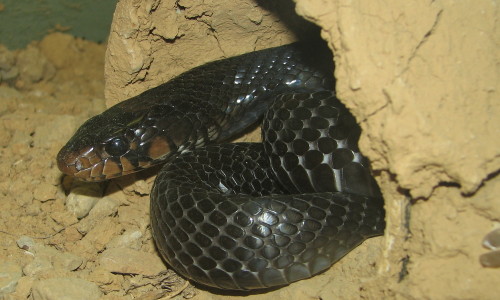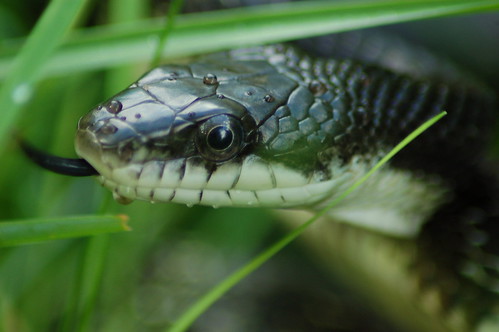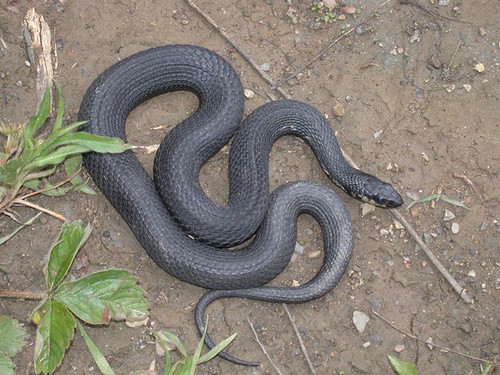Any snake, so long as it’s black
Black is beautiful — especially when it comes to our animals. So many people have a special fondness for black animals — black cats, black Labs, black horses (why else would two major children’s book series about horses be about black horses?) — and snakes are no exception. Check a reptile discussion board, and sooner or later you’ll find someone who’s looking for a solid black snake; earlier this year, one of my friends went positively gaga over the notion of laying hands on a black snake. This entry is for them: I’m going to go over the black snakes most commonly seen in the pet trade.
As far as black snakes are concerned, the gold standard is, without question, the Eastern Indigo Snake (Drymarchon corais couperi). A big, heavy-bodied snake with glossy, iridescent scales, the eastern indigo is the largest snake north of Mexico. While they will generally gobble down anything they can, they’re surprisingly docile with human beings, so much so that they have a reputation for being one of the tamest snakes in the world. (On the other hand, I’m told that an indigo bite, on those rare occasions it does occur, is unforgettable. Indigos aren’t constrictors; they bite hard.)
Eastern Indigo Snake, Louisville Zoo, 2008. Photo by Trisha Shears (public domain).
Listed as a threatened species since 1978, thanks to habitat destruction and overcollection (it was very popular in the day), indigo snakes are now rather hard to come by. Due to Lacey Act restrictions, even captive-bred snakes can’t cross state lines or be exported from the U.S. freely. Very few Canadian herpetoculturists work with indigos, which are extremely hard to breed; those few babies that make an appearance are snapped up quickly, and at high prices. I’m still kicking myself for not grabbing an eastern indigo I saw for sale at a reptile show eight years ago for less than $600; the going price is around double that nowadays, I think.
They’re not perfect snakes: because they’re so big, they require enormous cages; because they’re cannibalistic, they have to be housed one to a cage; they’re heavily parasite-laden; and their feces smells so awful it makes garter snake musk seem like sweet, sweet perfume in comparison.
I’ve wanted one very badly ever since I was a kid.
If you can’t afford or even find an indigo snake, there are several alternatives that cost a lot less and are a lot easier to care for. Black Rat Snakes (Elaphe obsoleta obsoleta until recently; see my entry on rat snake taxonomy) and Black Pine Snakes (Pituophis melanoleucus lodingi) have a lot going for them. Both are constrictors; both can be kept more than one to a cage; both are reasonably tame and quite easy to keep. They aren’t small snakes — black pines can get up to six feet, black rats up to eight — but they’re a little smaller and less active than indigos. They’re also much less stinky and considerably less expensive.
Black Rat Snake, Sugarland, Maryland, 2008. Photo by Carly & Art (CC licenced).
Black Rat Snakes are usually reasonably tame (except when young), less active, less stinky, and considerably less expensive. Their scales are slightly keeled, not smooth like an indigo’s, and they’re not pure black snakes. All rat snakes start out as gray snakes with dark saddles, and assume their adult colouration as they grow. An adult black rat snake will still retain some patterning; some of them aren’t very black. If you want your snakes solid black, this isn’t one for you. But, where they’re legal, they can be one of the cheapest captive-bred snakes available, and they’re probably the easiest snake to take care of that I mention in this entry. Unfortunately, while they’re extremely common in some parts of their range, they’re a threatened species in Ontario (the northermost limit of their range), which rules it out for many of my friends. I suppose I could keep one here in Quebec, but I’d never be able to cross the river with it.
I do keep two Black Pine Snakes, which a friend once referred to as the “poor man’s indigo.” Like black rats, they are blotched snakes that get darker with age: under strong lighting you can see the saddles in most cases, even on adults. Mine come from a particularly black bloodline and were black even as juveniles, but this is not something you can expect with every black pine. Regardless, they’re great snakes: big and muscular, shorter and heavier-set than black rats, and almost as easy to keep. (For one thing, both rats and pines can be kept more than one to a cage.) They’re essentially the same as any other pine snake or bullsnake, which means that they can be a little feisty can hiss really loudly when they feel threatened, but mine have been real sweethearts with terrific appetites. I love them.
Neither of these snakes are glossy black; if you want that, you might want to look at the black kingsnakes and milk snakes.
Two subspecies of the Common Kingsnake (Lampropeltis getula) may be of interest. The Mexican Black Kingsnake (L. g. nigrita) is the most common of the two: solid black, smaller in size, and widely available in pet stores or from breeders. It’s probably your best choice among kings and milks (and, coincidentally, has also been called “the poor man’s indigo”). The Black Kingsnake (L. g. nigra) is less commonly seen and less satisfying a captive, and retains a certain amount of the pattern seen in, for example, Speckled Kingsnakes (L. g. holbrooki). All kingsnakes are cannibalistic and must be kept one to a cage. In addition, I should mention that most of the common kings I’ve encountered have had an annoying tendency to calmly and deliberately chew on their handlers after a few minutes (whereas rat and pine snakes will simply strike when agitated, with plenty of advance warning). As a result, I wouldn’t recommend common kings to people who are averse to being bitten.
A more unusual option is the Black Milk Snake (Lampropeltis triangulum gaigeae), a large Central American subspecies that starts out like any other tricoloured milk snake but turns black with age. They’re starting to be more commonly seen in the pet trade, but the last time I checked they were still expensive — cheaper than an indigo, but more expensive than anything else here.
Finally, there is always the possibility of a melanistic specimen of an ordinarly not-black snake. Melanism is a recessive mutation like albinism that takes an ordinary animal and makes it solid black, or nearly so. Unlike albinism, melanism can confer some survival advantages: for snakes, it makes them better able to soak up the sun. (It’s no accident that Black Rat Snakes and Indigo Snakes, for example, are the northernmost representatives of their respective species; each snake’s more southerly cousins are not black at all.)
Melanistic Eastern Garter Snake, Pelee Island, Ontario, 2002. My photo.
Melanistic Eastern Garter Snakes (Thamnophis sirtalis sirtalis) make up about one-third of the total eastern garter population along the north shore of Lake Erie, and these snakes have found their way into that tiny niche of the pet trade that is inexplicably fond of garter snakes. They’re like any other garter snake, and can be cared for as such (naturally, you should visit my site about garter snakes, Gartersnake.info, for more information about garter snake care). I had a captive-bred melanistic male in 2000-2001 who exhibited a strong preference for fish and had, as a result, persistent parasitic infections that he eventually succumbed to. I think most of the captive melanistic garters I’m aware of come from Long Point, Ontario, where the local garter snakes feed preferentially on fish and amphibians; they’re a little harder to get to eat earthworms or (ideally) rodents.
A few black snakes aren’t really viable options: Black Racers (Coluber constrictor) are high-strung, hyper and really fond of biting people; Black Swamp Snakes (Seminatrix pygaea) have difficult care requirements. Neither of them are found in the pet trade very much. But if you’re interested in a snake so long as it’s black, you’ve got plenty of options.


